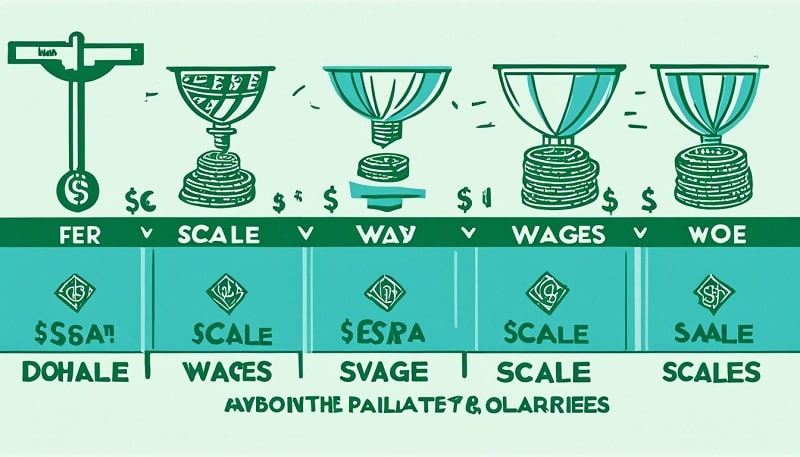
As a business owner or a manager, understanding the dynamic employee compensation options is key to cultivating a productive and satisfied workforce. Knowing the distinctions and applying the best fit for your company requires scrutiny of your business's specific needs and regulatory compliance.
Whether your business thrives on adaptable working hours or hinges on stable professional inputs, the pay structure you implement can significantly impact your team's motivation and your company's financial health.
It's essential to evaluate the nature of your workplace roles, legal guidelines, and the expectations you have from your team in order to make an educated and strategic choice.
Understanding Hourly and Salaried Compensation Models
When determining wage payment methods for your team, it's essential to weigh the question, "should you pay employees hourly or salary?" This pivotal decision beckons a deep dive into the employee compensation options available to you.
Distinctions between hourly versus salaried employees are not just administrative - they reflect the strategic approach you adopt towards remuneration and business operations.
Comprehending the fundamental differences in compensation models is crucial to comparing hourly and salary wages. Moreover, adhering to labor laws ensures not only the legality of your pay structure but also the satisfaction and retention of your workforce.
Definition and Basic Differences
Hourly vs salary - which is the best fit for your business? The distinction begins at compensation calculation. Hourly employees receive a specific amount for each hour worked, opening up avenues for overtime compensation under the standard 40-hour workweek.
In contrast, salaried employees are paid a standard flat rate per pay period, irrespective of the hours they put in, a model that generally excludes overtime payments. The choice between these structures can influence everything from operational flexibility to payroll management.
Laws Governing Hourly and Salaried Employees
Navigating the legal landscape that surrounds employee wages - knowing the salary vs hourly pay considerations - is vital. The Fair Labor Standards Act (FLSA) categorizes employees into exempt and nonexempt statuses, dictating eligibility for overtime wages.
Nonexempt, typically hourly employees, must be compensated at least the minimum wage, with eligibility for overtime. In contrast, exempt employees, generally salaried, meet a salary threshold and hold job duties mandating a degree of autonomy, thus excluding them from overtime.
Converting Hourly to Salary and Vice Versa
The strategic shift between hourly and salaried status is not uncommon, yet it requires meticulous adherence to regulations. Transitioning an hourly employee to a salaried role must align with FLSA requisites, considering the potential impact on the employee's benefits and responsibilities.
Similarly, converting a salaried position to hourly is also possible but necessitates a transparent articulation of rate adjustments and contract alterations. Each shift in employee compensation options should be scrutinized legally and communicated effectively, ensuring that every wage payment method you employ has the consent of both parties and complies with labor laws.
Should You Pay Employees Hourly or Salary?

Hourly positions are typically attuned to roles that demand flexibility in scheduling and are often subject to the ebb and flow of business demands. If your company deals with seasonal peaks or has varying revenue streams, an hourly pay structure may offer the flexibility necessary to efficiently manage labor costs.
On the other side of the coin, salary-based compensation tends to be associated with higher-level positions that entail a significant measure of independence and responsibility.
Benefits of hourly and salary employees:
- Hourly Employees: Benefit from pay for the actual hours worked and potential overtime compensation.
- Salaried Employees: Enjoy steady income and may have access to a broader range of benefits.
When roles require expertise that goes beyond a standard 40-hour week, a salaried model can provide the expected stability and consistency both in workload for the employee and in financial planning for your company.
Moreover, compliance with state laws is a critical component when determining your approach to compensation. The Fair Labor Standards Act (FLSA) delineates clear directives on exempt and non-exempt statuses.
| Considerations | Hourly | Salary |
|---|---|---|
| Stability of Earnings | Varies with hours worked | Consistent pay period to pay period |
| Overtime Eligibility | Yes, typically at a higher rate | No, unless outlined in employment contract |
| Benefits Availability | Dependent on hours and policy | Often more comprehensive |
| Workweek Flexibility | Aligned with business needs | Potentially more fixed |
Ultimately, your decision will hinge on what's most efficient and equitable for both the management and the employees who drive your business forward.
Deciding on the optimal employee compensation options for your business involves scrutinizing a variety of factors. The dilemma of choosing between hourly and salary pay cannot be resolved with a one-size-fits-all answer.
Instead, it requires a deep understanding of your organizational structure, the nature of the jobs within, the legal landscape, and broader market trends. More than just a pay structure comparison, it's about aligning your long-term business strategy with the wellbeing of your employees.
Pros and Cons of Hourly Wages for Your Workforce

As you consider employee payment models, understanding the advantages and challenges of hourly wages is crucial.
Overtime Compensation and Work-Life Balance
The capacity for overtime compensation is a prominent benefit for hourly employees. The opportunity to earn higher wages during peak business periods is an enticing prospect for many workers.
This wage payment method particularly suits businesses that see variable demand, allowing you to effectively manage labor costs while providing employees with the chance to increase their earnings. However, this model also risks pushing employees toward longer hours, which could disrupt the work-life balance you aim to uphold in your organization.
The Impact of Inconsistent Schedules on Employee Well-being
Inconsistent scheduling can be a drawback when comparing hourly and salary wages. Hourly employees may face fluctuating schedules that make it difficult to plan their personal lives or budget effectively.
Further, the uncertainty surrounding monthly income might prevent hourly staff from accessing certain benefits and stability often available to salaried counterparts, such as health insurance or paid vacation.
Regulatory Compliance with Hourly Pay
To remain compliant with labor laws, you'll need to pay close attention to regulatory compliance with hourly pay. Ensuring hourly versus salaried employees are classified correctly according to the Fair Labor Standards Act (FLSA) is a non-negotiable aspect of choosing between hourly and salary pay.
Accurate time tracking and wage calculation are indispensable elements of managing an hourly workforce, as penalties for noncompliance can include fines and back wages.
Pro's and con's of hourly employment:
- Clear separation of professional and personal time
- Possibility of negatively affecting work-life balance due to overworking
- Challenges in personal planning due to variable hours
- Risk of inaccessibility to benefits typically given to salaried employees
- Stringent employment laws requiring meticulous record-keeping
When considering wage payment methods, it's important to weigh these factors carefully. Opting for an hourly pay structure has potential benefits for both employees and employers, but it also bears certain disadvantages that could impact employee satisfaction and your business's legal and financial standing.
Benefits and Drawbacks of Salary Pay Structures

As you navigate the complexities of employee compensation options, you'll find that adopting a salary pay structure often brings a suite of advantages to the table. Salaried positions promise a consistent income, which is pivotal for both financial planning and steadiness, that hourly roles may not always be able to provide.
For your employees, this consistent pay is coupled with incentives such as comprehensive health insurance and robust retirement plans, making these roles highly desirable.
Pro's of salary pay structure:
- Consistent Income: Salaried positions provide a stable and predictable income, allowing for better financial planning and stability compared to hourly roles.
- Comprehensive Benefits: Salaried employees often receive comprehensive benefits such as health insurance and retirement plans, making these positions highly attractive.
- Flexible Work Arrangements: Salary-based roles often offer opportunities for flexible work arrangements, including negotiable work hours or remote work options. This contributes to job satisfaction and overall well-being.
With salary-based roles often come opportunities for flexible work arrangements, including negotiable work hours or remote work options. Such flexibilities contribute to job satisfaction and can be a significant factor in your employees' overall well-being and productivity.
However, when considering salary vs hourly pay considerations, be mindful that these benefits carry their own challenges. The latitude that salaried positions grant can sometimes blur the boundaries of work expectations, often leading to scenarios where hourly versus salaried employees might face off-balance work-life dynamics.
Con's of salary pay structure:
- Blurred Work Expectations: The flexibility of salaried positions can sometimes lead to blurred boundaries in work expectations. This can result in imbalanced work-life dynamics, particularly when comparing hourly and salaried employees.
- Uncompensated Overtime: Salaried individuals may be expected to work additional hours without receiving overtime pay. This can lead to situations where job demands exceed the agreed-upon compensation, potentially causing strain and dissatisfaction.
- Lack of Clearly Outlined Job Boundaries: Without clearly defined job boundaries, salaried employees may find it challenging to maintain a healthy work-life balance and may experience discontent if expectations exceed the agreed-upon compensation.
It's not rare for salaried individuals to spend extra hours catering to job demands without additional compensation, as overtime pay is generally not included for these workers. This could inadvertently lead to working situations where expectations surpass the agreed-upon compensation, potentially causing strain and discontent in the absence of clearly outlined job boundaries.
Given these nuances, honing in on the optimal employee compensation strategy demands that you weigh the pros and cons carefully. Evaluating not just the financial implications but also the holistic impact on employee satisfaction in the context of hourly versus salaried employment is essential.
What factors are you considering when deciding between hourly and salary pay structures for your company?








